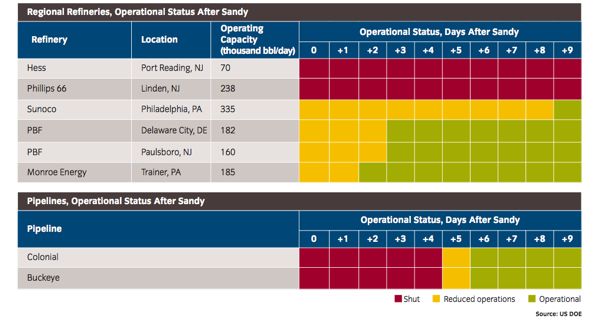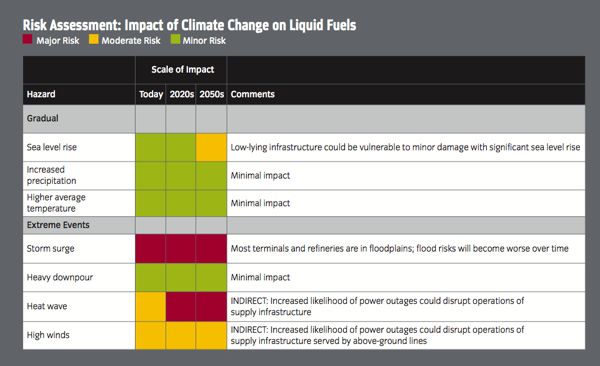Pilgrim Pipeline Would Make Tri-State Region More Vulnerable
Fossil infrastructure “an exercise in lunacy that must be stopped”
[Important Update on Pipeline tactics below]
As a result of the catastrophic climate change crisis we face, I oppose any investment in fossil fuel infrastructure and think that should be the most prominent reason for opposing the Pilgrim Pipeline, but without going into all that, just a quick note to rebut one of the big lies I just read by the spokesman for Pilgrim Pipeline, specifically this from the Morris Daily Record story:
George Bochis, vice president of development, Pilgrim Pipelines Holdings, said the Pilgrim Pipeline would remove 1,000 barges off the river each year and help alleviate shortages of critical fuels for families and businesses after severe weather events such as Hurricane Sandy, decreasing recovery times for affected areas.
The Linden refinery, which would receive the Pilgrim Pipeline oil, is highly vulnerable to climate change impacts and in fact – as shown by the chart above – was knocked out for over a week by Sandy. The Colonial and Buckeye pipelines were knocked out as well.
While the Christie Administration in NJ lacks a Climate Change Adaptation Plan, thankfully, our NY neighbors are no so irresponsible.
According to the NY City Climate Adaptation Plan (Chapter 7 – Liquid Fuels) – an analysis you can’t get from the Christie Administration, despite the fact that critical infrastructure is located in NJ:
What Happened During Sandy
Disruptions occurred at nearly every level of the fuel supply chain, reducing all fuel flow into and within the New York metropolitan area. Most of the infrastructure affected was located in New Jersey, where a combination of extended power outages and direct damage from storm surge, for a time, nearly dried up New York City’s fuel supply.
Despite widespread failures throughout the supply chain during and after Sandy, a lack of available information on the operational status of terminals, pipelines, refineries, and other key infrastructure delayed situational awareness for several days. Duplicative efforts among different governmental entities to secure information further delayed diagnosis of the cause of the supply disruptions and resulted in conflicting reports and, at least initially, responses that did not properly address the underlying issues.
Hurricane Sandy dramatically reduced output at refineries that supply New York City. While Philadelphia refineries were not greatly affected by the storm and reopened fairly quickly, two northern New Jersey refineries were closed for extended periods. The owners of these regional refineries partially shut down their facilities before the storm to minimize damage to equipment, eliminating 35 to 40 percent of the region’s total supply capacity preemptively. Despite this prudent preparation, storm surge damage to electrical equipment at two of the six refineries delayed their restarting, reducing regional refining capacity by 26 percent. Although both refineries eventually reopened several weeks later, one of the two subsequently was permanently closed, due to market conditions. (See chart: Regional Refiner- ies, Operational Status After Sandy)
The Colonial and Buckeye pipelines also were impacted by Sandy, shutting down for four days due to extensive power outages in New Jersey. This reduced total supply in the region by another 35 to 40 percent. Even after backup power generators were deployed and utility power was restored, it is likely that the flow of fuel through these pipelines still did not reach pre-storm levels for several days because of bot- tlenecks at the terminals that they supplied. (See chart: Pipelines, Operational Status After Sandy)
Of all of the ways in which Sandy interfered with the liquid fuel supply chain in the New York re- gion, perhaps the most significant was the damage to the area’s terminals. This damage took multiple forms. For example, docks at some terminals were destroyed, making it im- possible for those terminals to ship or receive fuel. In many cases, damage to electrical equip- ment reduced the capacity of impacted termi- nals to dispense fuel to delivery trucks that service gas stations. Additionally, damage to storage tanks at several terminals resulted in spills into area waterways totaling some 460,000 gallons of fuel around the city. And, as a result of the large amount of storm-related debris in the harbor immediately following Sandy, the US Coast Guard placed restrictions on port traffic for days until the waterways were deemed safe for use. As a result, even if a ter- minal were otherwise able to operate, many were still, for a period, unable to dispense or re- ceive tanker and barge shipments, reducing supply capacity by an additional 20 to 25 per- cent. Overall, for three days after Sandy, all fuel terminals in the New York metropolitan region were completely out of service. Even 10 days after the storm, only 79 percent were operational. (See chart: New York Metropolitan Area Fuel Terminals, Operational Status after Sandy)
[read the entire chapter and complete Report, it is superb.]
The NYC Plan provides an excellent diagnosis of the liquid fuel supply chain vulnerabilities.
The Plan outlines 9 specific initiatives for “increasing resiliency in the liquid fuels system” – none of which recommend another oil pipeline to serve the region to reduce those vulnerabilities – just the opposite.
North Dakota oil imports will exacerbate climate change and increase risks of extreme weather and power outages at refinery and liquid fuel infrastructure.
In addition, the Linden refinery is highly vulnerable to climate change as a result of its location.
The NYC Plan finds that these “risks will become worse over time”.
The last thing the planet and our region needs is another fossil fuel pipeline and an expansion of fossil infrastructure.
Given that oil will increase the probability and magnitude of extreme weather events, it is ludicrous – and tragically ironic – for Pilgrim Pipeline spokespeople to attempt to justify the project as to “help alleviate shortages of critical fuels for families and businesses after severe weather events”.
What Could Happen in the Future
The risks that extreme weather events pose to the liquid fuels supply chain are, as Sandy showed, serious if not addressed. The systematic failure that occurred as a result of Sandy’s storm surge revealed that there are already significant challenges today. These challenges will only be exacerbated by climate change in the future.
Major Risks
Given the existing locations of key terminals, pipelines, and refineries, and the importance of waterfront access for the movement of fuels into New York City, the greatest risk to the liquid fuel supply is storm surge. Of the 39 fuel termi- nals in the New York metropolitan area, nearly all lie within FEMA’s 100-year floodplain. The same is also true of the refinery in northern New Jersey as of the writing of this report. As the climate changes, the frequency of the most intense hurricanes is likely to increase, potentially increasing the risk to these facilities. (See map: Regional Liquid Fuel Terminals.)
Not only do extreme weather events cause direct damage to key liquid fuel assets in the region, they also disrupt the power infrastruc-ture critical to the functioning of terminals, refineries, and pipelines. Although utilities must meet current reliability standards, the increased frequency and severity of heat waves and storm surges associated with the most intense coastal storms are likely to increase the frequency of power disruptions throughout the region that would, in turn, render key refineries, pipelines, and terminals inoperable (see Chapter 6, Utilities). Given the high energy requirements of pipelines and refineries, backup generation may only provide limited operability during utility power outages. Additionally, if power were out for more than a few hours, refineries would quickly shut down, after which it would take weeks to restart them. Gas stations and terminals, which generally do not have on-site backup generation, also are fully reliant on utility power.
Other Risks
High winds present moderate risks to the liquid fuels supply chain. Wind events could result in direct damage to refineries, which have tall dis- tillation columns that are critical to the process- ing of crude oil. In addition, if wind events affect the availability of utility-supplied electric power, they will also impact terminals, refineries, pipelines, and gas stations.
[Update – a message from our friends in Rising Tide Vermont:
Sara Mehalick, a resident of Plainfield, Vermont, has locked her neck to the main entrance of the building, effectively blockading the doors shut. She released a statement about why she undertook today’s action:
Today I’m taking action because Vermont Gas is intent upon shackling our communities to fossil fuels, and condemning us to irreversible climate change. We have a responsibility to the communities whose land, water, and air are being poisoned by fracking, and we’re determined to make sure that this fracked gas pipeline does not move forward. Today we’re here to tell Vermont Gas to cancel their construction plans, or expect to see growing resistance.
Jonathan Shapiro, with Rising Tide Vermont, said “Climate change is already driving heat waves, torrential rains, and flooding in the Northeast, which is only predicted to worsen in the coming years. In this context of mounting climate crisis, building new fossil fuel infrastructure is an exercise in complete lunacy and must be stopped.”

